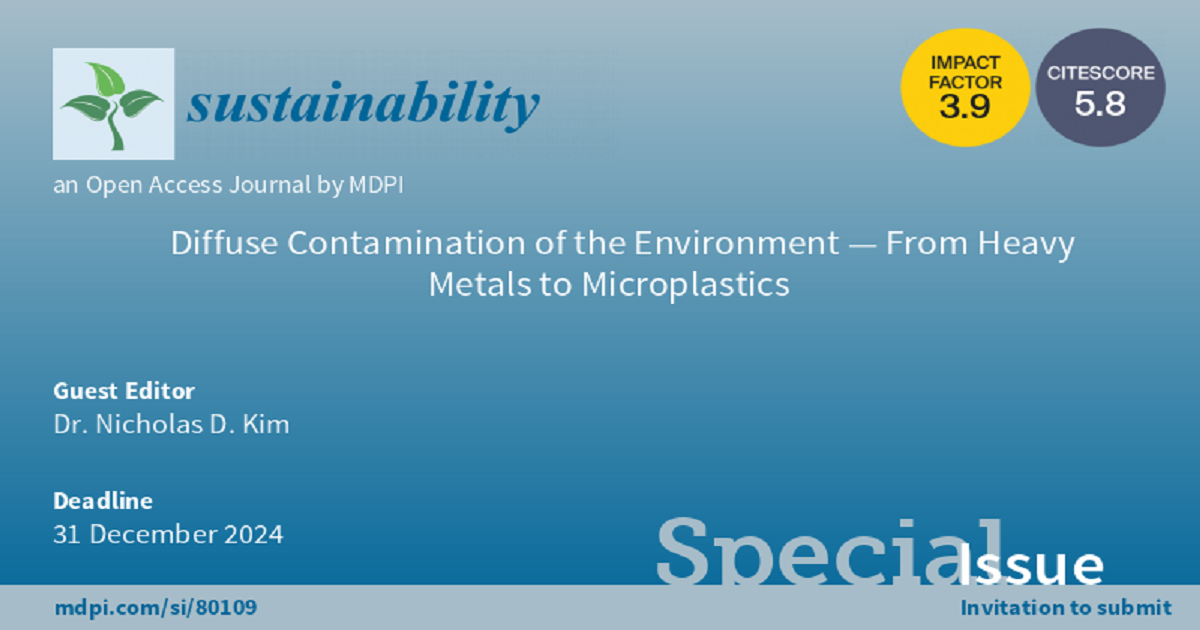Diffuse Contamination of the Environment — From Heavy Metals to Microplastics
A special issue of Sustainability (ISSN 2071-1050). This special issue belongs to the section "Sustainable Chemical Engineering and Technology".
Deadline for manuscript submissions: 31 December 2024 | Viewed by 5235

Special Issue Editor
Interests: applied environmental chemistry; diffuse chemical contamination; human and environmental risk assessment; science advice to regulatory and policy processes
Special Issues, Collections and Topics in MDPI journals
Special Issue Information
Dear Colleagues,
Local, regional, and global environments are subject to a range of diffuse contamination issues that are caused or exacerbated by human activity. Some of these involve naturally occurring elements and compounds, whereas others relate to xenobiotics. Some are inconsequential, whereas others may pose serious threats to ecosystems, human health, and economic activity. Many are only poorly or partially characterized.
In this second Special Issue devoted to diffuse contamination of the environment, we invite any papers that explore the spread, status, environmental behavior, and/or potential significance of any instance of diffuse contamination, from heavy metals to microplastics. Papers relating to any diffuse contamination issue are welcomed, and the scope is wide to facilitate a broader conversation.
The selected topic may:
- involve one element or compound, or a class or category of substances;
- focus on one environmental compartment or be multicompartmental;
- take the form of a research paper or a systematic review article;
- include the results of specific monitoring investigations, or modeling studies, or applicable epidemiological investigations.
Dr. Nicholas D. Kim
Guest Editor
Manuscript Submission Information
Manuscripts should be submitted online at www.mdpi.com by registering and logging in to this website. Once you are registered, click here to go to the submission form. Manuscripts can be submitted until the deadline. All submissions that pass pre-check are peer-reviewed. Accepted papers will be published continuously in the journal (as soon as accepted) and will be listed together on the special issue website. Research articles, review articles as well as short communications are invited. For planned papers, a title and short abstract (about 100 words) can be sent to the Editorial Office for announcement on this website.
Submitted manuscripts should not have been published previously, nor be under consideration for publication elsewhere (except conference proceedings papers). All manuscripts are thoroughly refereed through a single-blind peer-review process. A guide for authors and other relevant information for submission of manuscripts is available on the Instructions for Authors page. Sustainability is an international peer-reviewed open access semimonthly journal published by MDPI.
Please visit the Instructions for Authors page before submitting a manuscript. The Article Processing Charge (APC) for publication in this open access journal is 2400 CHF (Swiss Francs). Submitted papers should be well formatted and use good English. Authors may use MDPI's English editing service prior to publication or during author revisions.
Keywords
- diffuse contamination
- heavy metals
- xenobiotic substances
- emerging contaminants
- microplastics
- chemical contaminants
- science and public policy





